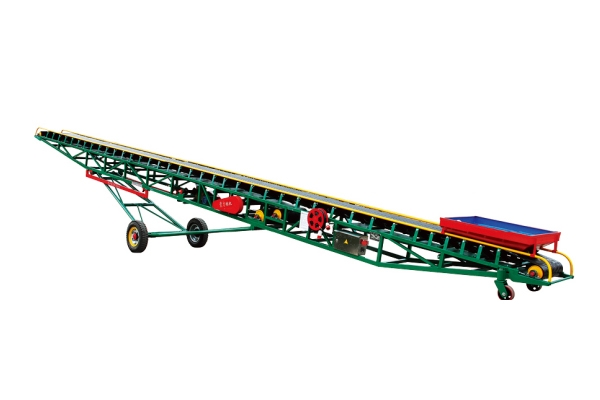Introduction of Mobile Loading Belt Conveyor
Introduction of Mobile Loading Belt Conveyor
At its heart, a mobile loading belt conveyor consists of five critical components, each engineered to ensure reliability and adaptability. The conveyor belt itself is the primary medium for material transport, with materials ranging from durable rubber (for heavy-duty industrial use) to food-grade PVC (for agricultural or pharmaceutical applications) to resist wear, moisture, and chemical corrosion. Modern belts often incorporate anti-slip coatings or cleats (raised ridges) to prevent material spillage during inclined transport, a common challenge in loading/unloading tasks.

The drive system powers the belt’s movement, typically featuring an electric motor (ranging from 1.5 kW to 15 kW, depending on load capacity) paired with a gearbox for speed regulation. Unlike fixed conveyors that rely on hardwired power, mobile models often include portable generators or rechargeable lithium-ion batteries, allowing operation in remote sites—such as construction yards or rural farms—without access to grid electricity.
Portability is enabled by the mobile chassis, which is mounted on heavy-duty rubber tires or tracks. Tires are preferred for smooth surfaces (e.g., warehouse floors), while tracks suit uneven terrain (e.g., mining sites or construction lots). Many models also integrate hydraulic or manual height-adjustment mechanisms, enabling operators to modify the conveyor’s incline angle (from 0° to 30°, depending on material density) and length (standard ranges: 5 meters to 20 meters) to match loading docks, trucks, silos, or storage bins.
Safety is a paramount design consideration: emergency stop buttons are installed at both ends of the conveyor, while side guards and belt alignment sensors prevent accidents caused by material jams or belt misalignment. Some advanced models also include overload protection systems that automatically shut down the conveyor if the load exceeds its rated capacity (typically 500 kg/h to 5,000 kg/h for standard units), safeguarding both equipment and personnel.
The adaptability of mobile loading belt conveyors makes them indispensable across a wide range of sectors, addressing unique material handling challenges in each:
Agriculture: Farmers and grain processors use these conveyors to load/unload wheat, corn, and soybeans from trucks to silos or vice versa. Their portability allows movement between fields and storage facilities, eliminating the need for multiple fixed conveyors. Food-grade belts ensure compliance with hygiene standards, preventing contamination of edible goods.
Construction and Mining: In construction sites, mobile conveyors transfer sand, gravel, and concrete blocks from delivery trucks to mixing stations, reducing manual labor and speeding up project timelines. In mining operations, they handle crushed ores or coal, operating in harsh environments where fixed systems would be impractical to install or relocate.
Logistics and Warehousing: E-commerce and distribution centers rely on mobile conveyors to load packaged goods onto delivery trucks. Their adjustable height and length accommodate different truck sizes, while battery-powered operation allows flexibility in warehouse layouts—critical for facilities with frequent reconfiguration needs.
Waste Management: Municipalities use these conveyors to sort and load recyclable materials (e.g., cardboard, plastic) into waste trucks. Durable rubber belts resist punctures from sharp objects, ensuring long-term performance in high-debris environments.
Technical Advantages Over Fixed Conveyor Systems
Mobile loading belt conveyors offer distinct benefits that make them a superior choice for dynamic workplaces:
Unmatched Flexibility: Unlike fixed conveyors, which require permanent installation and cannot be relocated, mobile models can be moved within minutes. This is particularly valuable for temporary projects (e.g., seasonal farming or infrastructure repairs) or facilities with changing workflow demands.
News
Contact Us
Contact: Venka Industrial Technology
Phone: 13663827325
Tel: 13663827325
E-mail:
Add: High Technology Area, Zhengzhou, Henan, China